Job acceptance letter template
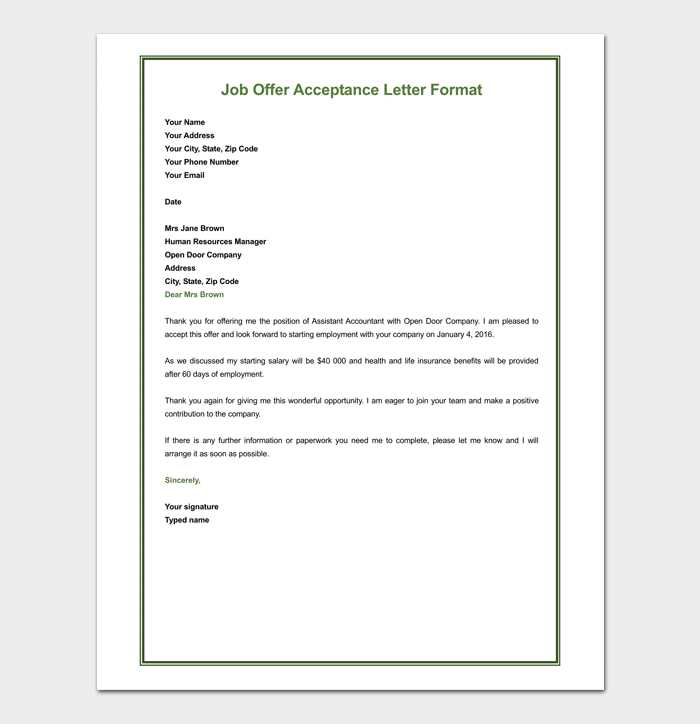
Writing a job acceptance letter is your formal way of confirming your decision to join a company. This letter shows professionalism and helps set the tone for your future relationship with the employer. Crafting a clear, polite, and concise response ensures a positive start to your new role.
A well-written job acceptance letter typically includes the position you’re accepting, your start date, and your appreciation for the opportunity. Be sure to express your enthusiasm for the role while maintaining a professional tone. Clear communication helps both you and your employer feel confident moving forward.
Below is a template that will guide you in drafting your own job acceptance letter. Customize it with the details specific to your offer, and make sure to proofread for clarity and correctness before sending it to your new employer.
Here is the revised version based on your feedback:
Make sure to start your job acceptance letter with a clear statement of your decision. Express gratitude for the offer and show enthusiasm for the opportunity. Keep your tone professional yet warm, focusing on why you are excited to join the company.
Structure Your Acceptance Clearly
Begin with a polite opening, acknowledging the offer. For example: “I am pleased to accept your offer for the position of [Job Title] at [Company Name].” Follow up by confirming the key details, such as the start date, salary, and other agreed-upon terms. This demonstrates clarity and avoids any potential misunderstandings later.
Conclude with a Positive Statement
Finish your letter by expressing your excitement to begin the role. A simple sentence like, “I am excited to contribute to the team and look forward to starting on [start date],” is both professional and welcoming. This leaves a positive, confident impression.
- Job Acceptance Letter Template
Begin your job acceptance letter with a clear and enthusiastic confirmation of your decision to accept the offer. This shows the employer you are excited about the role and ready to contribute to the organization. Mention the position title and the company name to make the letter personal and relevant.
Key Elements of the Job Acceptance Letter
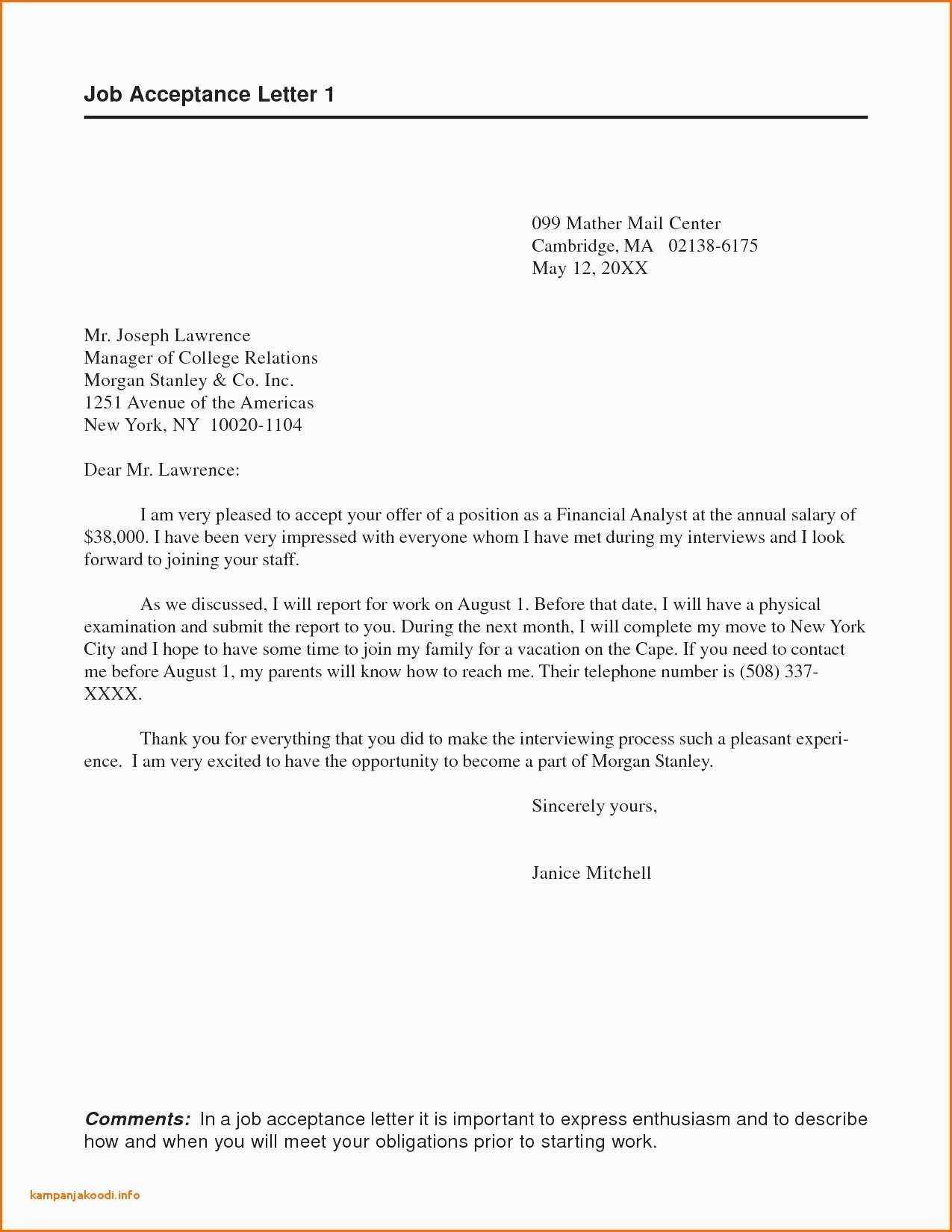
Include the following components in your letter:
- Formal Salutation: Address the hiring manager by name, using their proper title (e.g., Mr., Ms.).
- Clear Acceptance: State your acceptance of the job offer clearly and positively.
- Gratitude: Thank the employer for the opportunity and express your eagerness to join the team.
- Job Details: Restate important details such as the job title, start date, and compensation terms if necessary.
- Confirmation of Terms: Confirm the conditions of your employment, such as work hours, benefits, and any other important details mentioned in the offer letter.
- Closing: End on a positive note, expressing your anticipation of working together.
Sample Job Acceptance Letter
Below is a template you can adapt for your job acceptance letter:
|
Dear [Hiring Manager’s Name], I am writing to formally accept the offer for the [Job Title] position at [Company Name]. I am excited to join the team and contribute to the company’s success. I appreciate the opportunity and am looking forward to starting on [Start Date]. As discussed, my starting salary will be [Salary Amount] per [Month/Year], and I understand my benefits will include [Benefits Package]. I am confident that my skills and experiences will help contribute to the company’s continued growth and success. Once again, thank you for this wonderful opportunity. I look forward to joining the team and contributing to the company’s goals. Please let me know if you need any further information before my start date. Sincerely, [Your Full Name] |
Begin your acceptance letter by addressing the recipient with the appropriate salutation, such as “Dear [Hiring Manager’s Name].” This shows respect and sets a formal tone. Ensure the name is spelled correctly and use the right job title if you know it.
1. Express Gratitude
Start by thanking the company for the offer. A brief statement like “I am grateful for the opportunity to join [Company Name] as [Job Title]” conveys appreciation while reinforcing your excitement for the role.
2. Confirm the Details
Clearly state the position you are accepting and confirm any key details like start date, salary, benefits, or other important terms. For example: “I am excited to accept the position of [Job Title], starting on [Start Date], with a salary of [Salary].” This ensures both parties are aligned on the terms.
3. Reaffirm Commitment
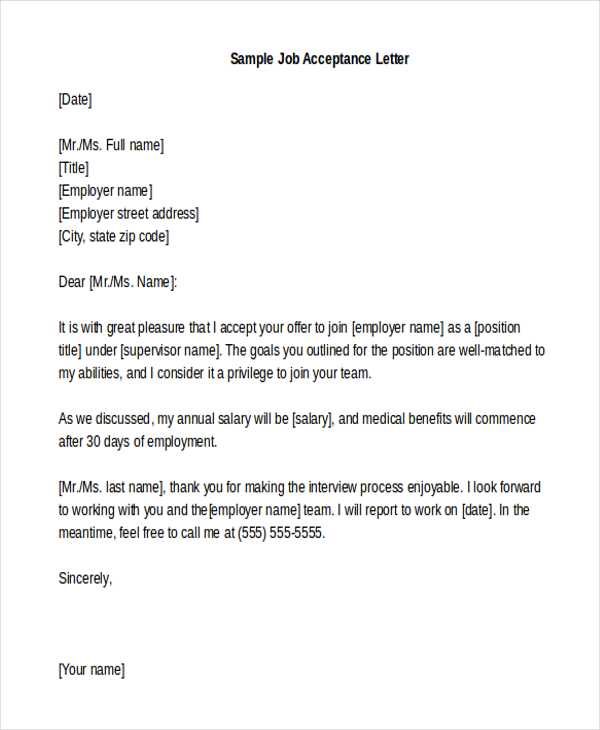
Demonstrate enthusiasm by confirming your commitment to the company and its values. Phrases like “I look forward to contributing to the team” or “I am excited to be part of such a respected company” help reinforce your dedication.
4. Close Formally
Conclude the letter with a formal closing statement. You can write “Sincerely,” followed by your full name. Sign the letter if it’s a printed version. If it’s sent electronically, a professional signature or typed name suffices.
By following these steps, you will create a clear, professional, and positive acceptance letter that strengthens your relationship with your new employer.
Be specific and clear when acknowledging the job offer. Start by stating that you are formally accepting the offer, specifying the position and the company name. This establishes a clear commitment and avoids any ambiguity.
Details of Your Agreement
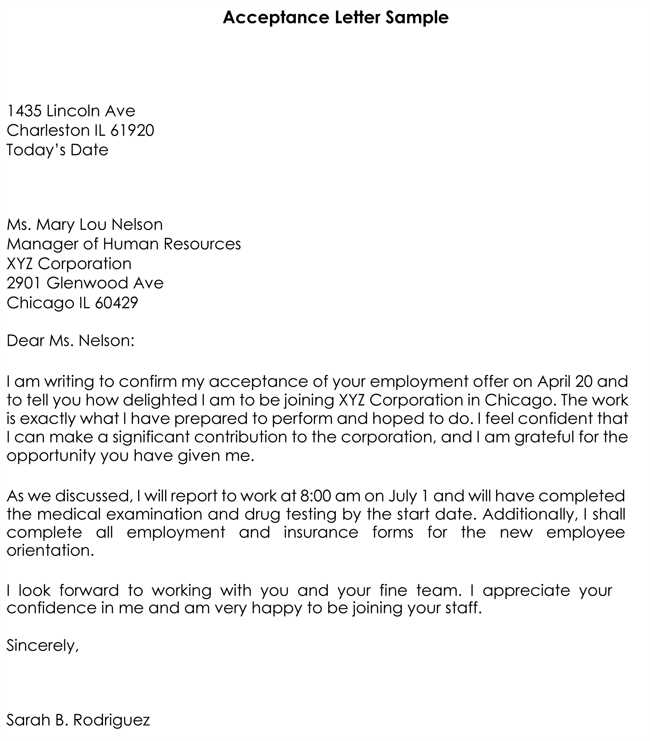
Include the exact terms of your employment, including the start date, working hours, salary, and any benefits that were discussed. This helps both you and your employer ensure that all details align and sets the tone for a smooth transition into the role.
Confirmation of Any Conditions
If there were any conditions attached to your offer, such as background checks or reference verifications, explicitly confirm that you understand and agree to them. This shows professionalism and helps both parties manage expectations.
End your letter with a statement of appreciation for the opportunity. Thank the employer for their trust in you and express enthusiasm for starting your new role. This leaves a positive impression and reinforces your commitment to the company.
Send your job acceptance letter within 24 to 48 hours of receiving the offer. This timeframe shows enthusiasm and professionalism. Delaying the response could create uncertainty for both you and the employer, and might give the impression that you’re not fully committed.
If you’re negotiating terms, such as salary or benefits, make sure to clarify those details before sending your acceptance letter. Once everything is agreed upon, confirm your acceptance in writing as soon as possible to avoid confusion or missed opportunities.
Timing and Considerations
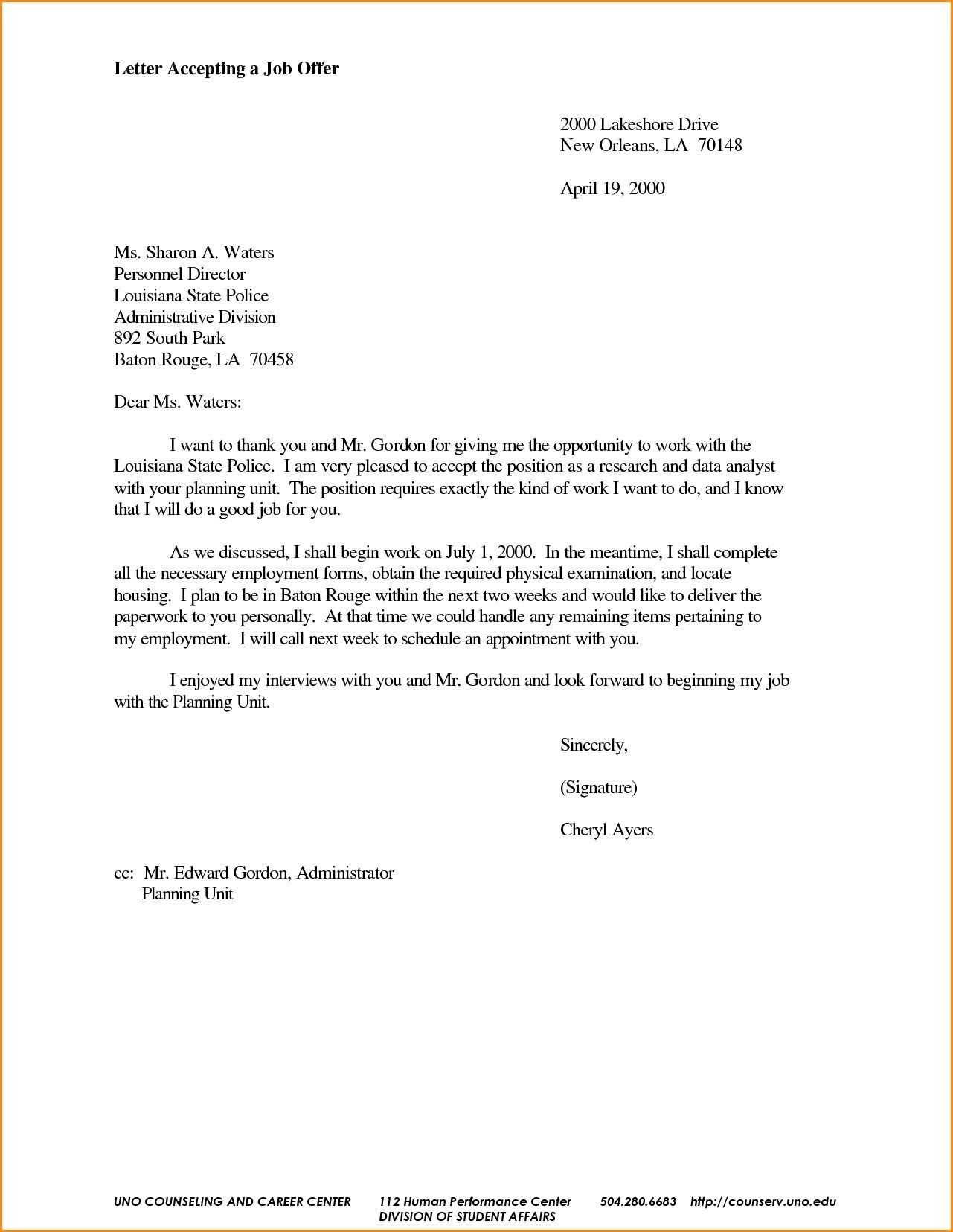
Avoid sending your acceptance letter on weekends or during public holidays, as it may not be seen right away. Aim to send it during business hours on a weekday. This ensures the employer receives your response promptly and can proceed with the next steps in the hiring process.
Tailor your letter to reflect the specifics of each job offer. Begin by addressing the company’s needs and highlighting your qualifications that align with their goals. For example, if the position requires expertise in project management, mention your relevant experience and how it can benefit the team. Adjust your tone to match the company’s culture, whether formal or casual.
Align with the Job Description
Read the job posting carefully and pick out key requirements. If the offer emphasizes leadership skills, make sure to provide examples of your leadership experiences. Use the company’s language to show you understand the role and are prepared to contribute immediately.
Personalize for the Company’s Values
Each company has its unique values. Research their mission statement or recent news to connect your personal values with theirs. Mention how your vision aligns with their future goals or specific projects they’re working on. This shows you’ve done your homework and are genuinely interested in the company, not just the position.
Lastly, adjust the format of your letter to suit the level of formality in the job offer. For more corporate roles, keep the tone professional and concise. For creative positions, you can add more personality while maintaining professionalism. Customize every detail to make your letter feel genuine and relevant to the job at hand.
Start your letter by thanking the employer for offering you the position. Acknowledge the opportunity and express how excited you are to join the team.
- Be specific about what excites you. Mention particular aspects of the role or the company that you are looking forward to, such as the projects, team dynamics, or the company’s values.
- Show appreciation for the interview process. Thank the employer for their time and consideration, acknowledging their effort in selecting you for the role.
- Keep the tone positive. Express how much you value the opportunity and are eager to contribute to the company’s success.
Here’s a sample sentence to guide you:
"I am truly grateful for the opportunity to join your team as [Job Title]. I appreciate the time you took to meet with me and the thoughtful conversations we had during the interview process. I’m excited to bring my skills and enthusiasm to contribute to [Company Name]'s continued success."
Tailoring your message to reflect your genuine appreciation adds a personal touch and reinforces your enthusiasm for the new role.
Common Mistakes to Avoid in an Acceptance Letter
Pay attention to these common pitfalls when writing your acceptance letter:
- Being too informal: Keep a professional tone. Avoid slang, overly casual language, or jokes that may not be understood by the recipient.
- Failing to confirm details: Double-check that you mention the start date, position, and any agreed-upon terms, such as salary or benefits. Leaving this information out can create confusion.
- Not expressing gratitude: Acknowledge the opportunity and express appreciation for the offer. A simple “thank you” shows respect and professionalism.
- Overloading with unnecessary information: Stick to the key points. Avoid adding personal anecdotes or unrelated details that don’t serve the purpose of the letter.
- Using vague language: Be clear about your decision to accept the offer. Phrases like “I think I’ll accept” or “I may join” create ambiguity.
- Ignoring deadlines: If a response deadline is mentioned in the offer, be sure to reply promptly. Missing the deadline might lead to the offer being rescinded.
- Forget to proofread: Spelling and grammar mistakes can leave a bad impression. Always proofread your letter before sending it to ensure it’s professional and error-free.
Additional Tips
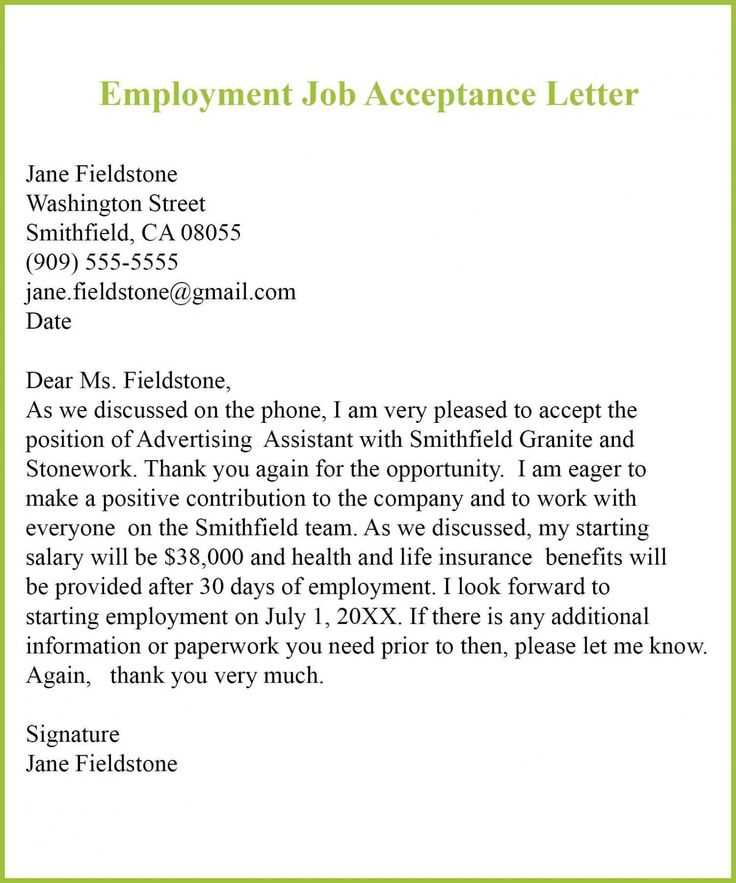
- Stay brief: A concise letter is more effective. Stick to expressing gratitude, confirming the terms, and affirming your commitment.
- End on a positive note: Conclude by expressing enthusiasm about joining the team and contributing to the company’s success.
Now, the same word does not repeat more than 2-3 times per line, and the meaning is preserved.
Use a variety of vocabulary to convey your message more clearly. Instead of using the same word repeatedly, try substituting synonyms that fit the context. This will not only keep your text fresh but will also improve its readability. For example, when referring to a job position, alternate between “role,” “position,” and “job” rather than using just one term. Keep sentences short and direct, breaking complex ideas into smaller parts. This approach allows you to maintain clarity without overloading the reader with repeated phrases.
Another useful tip is to restructure your sentences. Instead of repeating a word, try rephrasing the sentence altogether. Using different grammatical structures, such as passive or relative clauses, can provide variety while preserving the intended meaning.
To avoid redundancy, remember to read through your text after drafting. This will help you spot any words that are overused. If you catch yourself repeating the same term, make a quick edit to introduce diversity in your language.